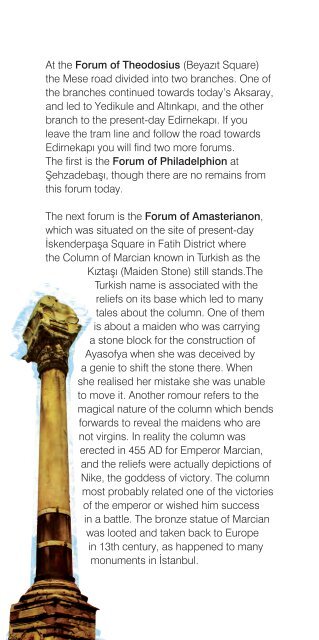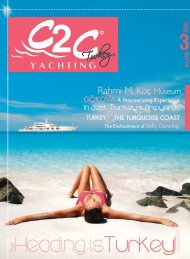istanbul - C2C
istanbul - C2C
istanbul - C2C
You also want an ePaper? Increase the reach of your titles
YUMPU automatically turns print PDFs into web optimized ePapers that Google loves.
28<br />
of serpents coiled over each other and<br />
at the top each serpent’s head was<br />
separated to form a tripod to hold<br />
a vessel where an eternal flame<br />
was kept burning for the memory<br />
of the war. The vessel had long<br />
disappeared and the serpent<br />
heads collapsed. The reason why<br />
Constantine brought the monument<br />
to İstanbul is interesting. The<br />
widespread belief of the period was<br />
that the monument, consisting of<br />
serpents, had a mystical power to<br />
keep İstanbul safe from snakes<br />
and vermin infestation. While the<br />
serpents’ necks and heads have<br />
not survived to our day, part<br />
of one head was found during<br />
excavations and can be seen<br />
at the İstanbul Archaeological<br />
Museums.<br />
Obelisk<br />
The Örme Sütun (Walled<br />
Obelisk) is the last of the<br />
extant monuments. It was<br />
commissioned by the Emperor<br />
Constantine VII in 944, and, as its<br />
name suggests, it was made of<br />
courses of masonry. When it was<br />
completed it supported a bronze<br />
sphere, and the marks of fixing<br />
studs in the masonry indicate<br />
that the obelisk was fully clad<br />
with bronze plaques depicting<br />
the wars of Emperor Basileus<br />
I of Macedonia. During the<br />
Latin occupation between 1204<br />
and 1261 those plaques were<br />
removed and melted down to<br />
make weapons, bronze goods<br />
and to mint money.



